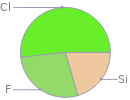Input interpretation

dichlorodifluorosilane | elemental composition
Result

Find the elemental composition for dichlorodifluorosilane in terms of the atom and mass percents: atom percent = N_i/N_atoms × 100% mass percent = (N_im_i)/m × 100% Plan: • Write the chemical formula and gather atomic masses from the periodic table. • Determine values for N_i, m_i, N_atoms and m using these items. • Finally, compute the percents and check the results. Write the chemical formula: SiCl_2F_2 Use the chemical formula to count the number of atoms, N_i, for each element and find the total number of atoms, N_atoms, per molecule: | number of atoms Cl (chlorine) | 2 F (fluorine) | 2 Si (silicon) | 1 N_atoms = 2 + 2 + 1 = 5 Divide each N_i by N_atoms to calculate atom fractions. Then use the property that atom fractions must sum to one to check the work: | number of atoms | atom fraction Cl (chlorine) | 2 | 2/5 F (fluorine) | 2 | 2/5 Si (silicon) | 1 | 1/5 Check: 2/5 + 2/5 + 1/5 = 1 Compute atom percents using the atom fractions: | number of atoms | atom percent Cl (chlorine) | 2 | 2/5 × 100% = 40.0% F (fluorine) | 2 | 2/5 × 100% = 40.0% Si (silicon) | 1 | 1/5 × 100% = 20.0% Look up the atomic mass, m_i, in unified atomic mass units, u, for each element in the periodic table: | number of atoms | atom percent | atomic mass/u Cl (chlorine) | 2 | 40.0% | 35.45 F (fluorine) | 2 | 40.0% | 18.998403163 Si (silicon) | 1 | 20.0% | 28.085 Multiply N_i by m_i to compute the mass for each element. Then sum those values to compute the molecular mass, m: | number of atoms | atom percent | atomic mass/u | mass/u Cl (chlorine) | 2 | 40.0% | 35.45 | 2 × 35.45 = 70.90 F (fluorine) | 2 | 40.0% | 18.998403163 | 2 × 18.998403163 = 37.996806326 Si (silicon) | 1 | 20.0% | 28.085 | 1 × 28.085 = 28.085 m = 70.90 u + 37.996806326 u + 28.085 u = 136.981806326 u Divide the mass for each element by m to calculate mass fractions. Then use the property that mass fractions must sum to one to check the work: | number of atoms | atom percent | mass fraction Cl (chlorine) | 2 | 40.0% | 70.90/136.981806326 F (fluorine) | 2 | 40.0% | 37.996806326/136.981806326 Si (silicon) | 1 | 20.0% | 28.085/136.981806326 Check: 70.90/136.981806326 + 37.996806326/136.981806326 + 28.085/136.981806326 = 1 Compute mass percents using the mass fractions: Answer: | | | number of atoms | atom percent | mass percent Cl (chlorine) | 2 | 40.0% | 70.90/136.981806326 × 100% = 51.76% F (fluorine) | 2 | 40.0% | 37.996806326/136.981806326 × 100% = 27.74% Si (silicon) | 1 | 20.0% | 28.085/136.981806326 × 100% = 20.50%
Mass fraction pie chart

Mass fraction pie chart